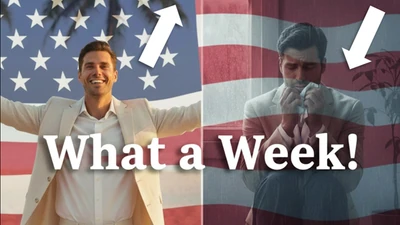As a conservative investor, I prioritize stability, long-term growth, and investments that strengthen America’s economic backbone. The U.S. Court of International Trade’s ruling on May 28, 2025, which halted President Trump’s “Liberation Day” tariffs, has thrown a wrench into the administration’s bold trade agenda. These tariffs—10% on most imports, with higher levies on countries like China (up to 145%), Canada, and Mexico (25%)—were designed to bolster American industry and reduce trade deficits. As someone who values policies that prioritize “Made in the USA,” I see both challenges and opportunities in this setback. Here’s my perspective on what comes next for the administration, how it affects my investment strategy, and how the president might regain control over tariffs to support American resilience.
Understanding the Court’s Decision
The court ruled that President Trump’s use of the International Emergency Economic Powers Act (IEEPA) to impose tariffs overstepped his authority, arguing that trade deficits and issues like immigration or drug trafficking don’t constitute an “unusual and extraordinary threat.” This decision paused the broad tariffs, though sector-specific levies on goods like steel, aluminum, and automobiles remain intact under other legal frameworks, such as Section 232 of the Trade Expansion Act. The White House has vowed to appeal, and negotiations with over 75 countries continue, with some deals—like a temporary reduction of China tariffs to 30%—already in motion.
For me, this ruling introduces uncertainty but also underscores the importance of staying grounded in fundamentals. Tariffs, while disruptive, aim to protect American jobs and industries, aligning with my belief in investing in companies that embody national strength. However, the legal roadblock demands a closer look at how the administration will respond and what it means for my portfolio.
The Administration’s Next Steps
As a conservative investor, I’m watching the administration’s moves closely, as they’ll shape the economic landscape:
- Legal Appeal: The White House is appealing to the U.S. Court of Appeals for the Federal Circuit, with a potential Supreme Court challenge if needed. A swift appeal or emergency stay could reinstate tariffs, preserving the administration’s leverage in trade talks. I appreciate the administration’s resolve, as tariffs can incentivize domestic production, benefiting companies I invest in, like those in manufacturing and logistics.
- Congressional Action: The Constitution gives Congress authority over tariffs, so the administration could seek legislation to grant the president broader tariff powers. While a divided Congress may resist, I’m hopeful for bipartisan support from lawmakers who see the value in protecting American industries. This path, though slow, could provide a stable legal foundation for tariffs.
- Alternative Legal Tools: The administration can pivot to statutes like Section 232 (national security) or Section 301 (unfair trade practices) to impose targeted tariffs. These require time for investigations, but their track record of judicial approval makes them reliable. As an investor, I value this predictability, as it minimizes market shocks.
- Trade Negotiations: The administration’s ongoing talks with countries like the EU, China, and South Korea could yield “America First” trade deals. The 90-day tariff pause has already sparked progress, and I’m optimistic that these negotiations will strengthen U.S. markets without excessive volatility.
- Closing Loopholes: The administration could tighten policies like the de minimis exemption, which allows duty-free imports under $800. Closing this loophole, which cost $10.8 billion in tariff revenue in 2024, would support fair trade and protect domestic businesses—key to my investment philosophy.
Implications for My Portfolio
As a conservative investor, I focus on stability, income, and companies that contribute to America’s economic resilience. The tariff halt has mixed effects on my strategy:
- Market Volatility: The market’s initial rally post-ruling, with gains up to 12% in a day, was a relief, but subsequent dips reflect uncertainty. I’m sticking to diversified, low-risk assets like dividend stocks (e.g., Fortis, VIG ETF) and bonds (e.g., VTC ETF), which weather volatility better than growth stocks. My portfolio, anchored in sectors like manufacturing (e.g., Caterpillar) and defense (e.g., Lockheed Martin), remains resilient, as these industries benefit from existing tariffs and national security priorities.
- Sector Opportunities: The ruling spares tariffs on steel, aluminum, and automobiles, supporting my holdings in companies like Nucor and General Motors. However, the pause on broader tariffs reduces pressure on foreign competitors, potentially impacting firms reliant on domestic protection. I’m monitoring logistics and consumer goods, sectors you’ve shown interest in, for opportunities if trade deals materialize.
- Inflation Concerns: Tariffs could raise consumer prices, a worry for my fixed-income investments. The court’s ruling delays this risk, but I’m prepared for potential inflation if tariffs are reinstated. My bond-heavy portfolio, with allocations to ETFs like VTC, offers a buffer against rising rates.
- Long-Term Outlook: The administration’s trade policies aim to revitalize American industry, aligning with my goal of supporting homegrown companies. A successful appeal or new trade deals could boost sectors like manufacturing, creating opportunities for stable, income-generating investments.
Restoring Presidential Tariff Control
To align with my investment goals, I’d like to see the president regain tariff authority in a way that minimizes market disruption. Here are viable solutions:
- New Legislation: A law granting the president explicit tariff powers for economic or security purposes would provide clarity. As an investor, I value the stability this would bring, ensuring predictable trade policies that support domestic industries.
- Leveraging Existing Laws: Using Section 232 or Section 301 allows targeted tariffs with less legal risk. These frameworks, proven in cases like USP Holdings, Inc. v. United States, align with my preference for methodical, low-risk strategies.
- Refined Emergency Powers: The administration could reframe tariffs under IEEPA by focusing on specific threats, like supply chain vulnerabilities. This approach, if carefully justified, could withstand judicial scrutiny while supporting American companies.
- Trade Agreements with Tariff Provisions: Negotiating deals that include tariff flexibility would balance free-market principles with domestic protection. This would reassure investors like me by fostering stable trade relationships.
My Conservative Take
As a conservative investor, I’m skeptical of narratives that paint tariffs as reckless. The establishment often overlooks the long-term benefits of protecting American jobs and reducing reliance on foreign goods. The court’s ruling, while a setback, doesn’t negate the administration’s goal of economic resilience—a goal I share. Tariffs, when applied strategically, can level the playing field for companies like those in my portfolio, from manufacturing giants to defense stalwarts. The administration’s push for fair trade deals and domestic growth resonates with my belief in American ingenuity and self-reliance.
However, I remain cautious. Volatility from legal battles or trade tensions could rattle markets, so I’m doubling down on diversified, income-focused investments. My strategy—rooted in stability, fiscal discipline, and support for American industry—positions me to weather this uncertainty while capitalizing on opportunities if the administration regains tariff control.
Final Thoughts
The Trade Court’s ruling is a hurdle, not a defeat, for President Trump’s trade agenda. As a conservative investor, I’m encouraged by the administration’s determination to appeal, negotiate, and explore alternative paths. By focusing on stable sectors, monitoring trade developments, and advocating for clear tariff authority, I can protect my portfolio while supporting policies that strengthen America. The road ahead may be bumpy, but with prudent planning, I’m confident in navigating this uncertainty while staying true to my values of stability and national resilience.










